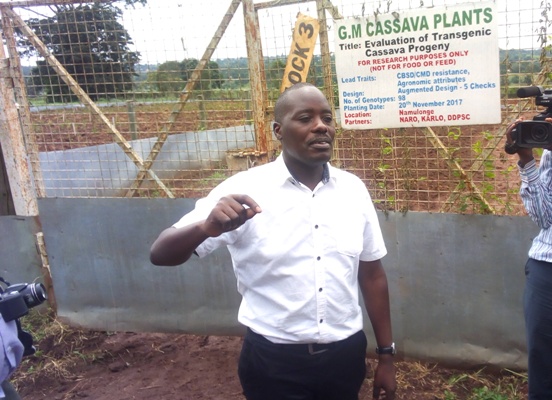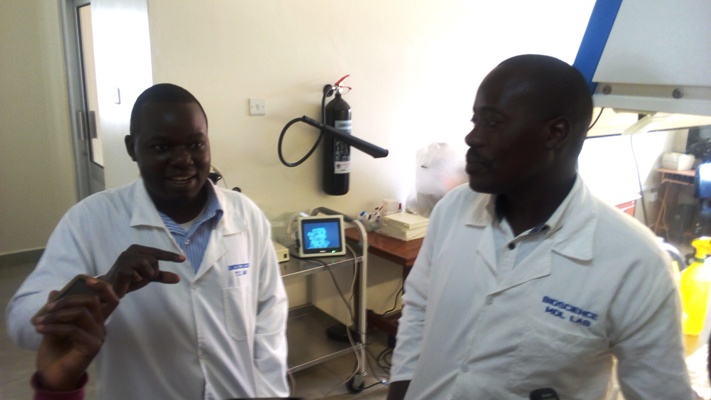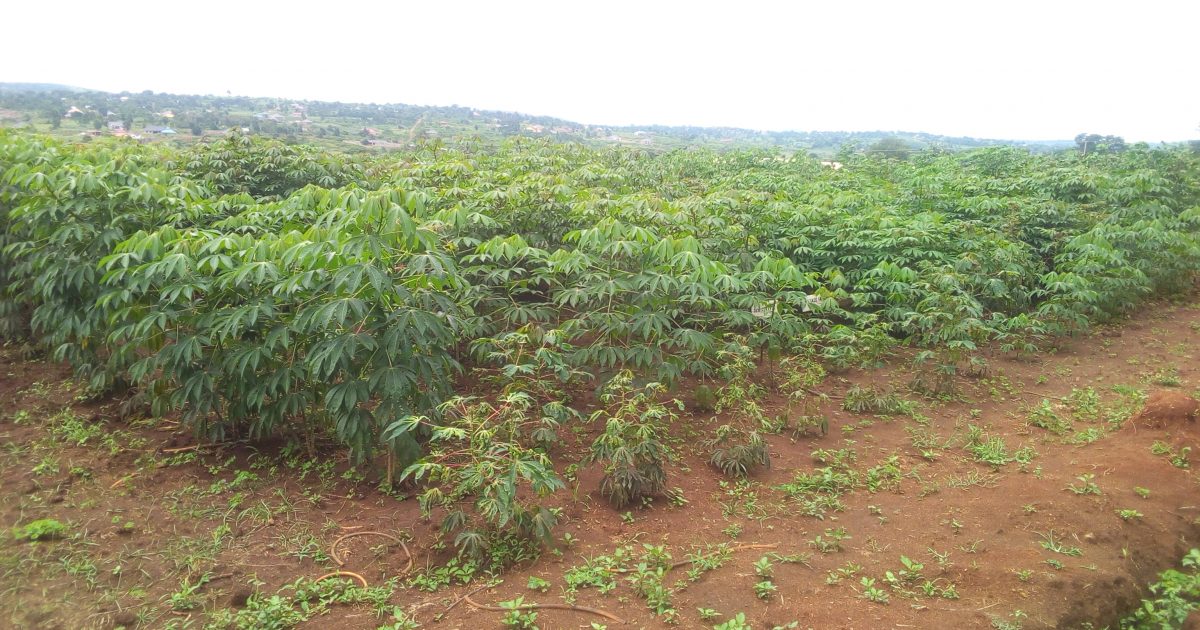On May24, 2018, a few journalists and I visited National Crop Resources Research Institute in Namulonge, located approximately 30 kilometres northeast of Kampala City.
The trip was to assess progress in research that entails developing Genetically Modified (GM) cassava that is resistant to Cassava Brown Streak Disease and Casssava Mosaic Disease – the two diseases ravaging the crop across the country and threatening food security.
Genetic modification in crops or even animals mainly involves adding a specific stretch of DNA into the plant’s genome –a complete set of genetic information in an organism – giving it new or different characteristics.
This could include changing the way the plant grows, or making it resistant to a particular disease. The new DNA becomes part of the GM plant’s genome which the seeds produced by these plants will contain.
As planned, Dr. Henry Wagaba, a scientist heading the GMO cassava research led us into the Bioscience Molecular Laboratory, at around 10am, purposely to see equipment, seedlings, and the processes involved in developing a GM crop.
It is also the regional centre of excellence for cassava research across the East Africa, implying that it holds all the cassava plant materials for cassava research across the region.
Four young scientists glad in white gowns synonymous to those of doctors in medical facilities could be seen busy carrying and mixing some plant components and nutrients in tiny tubes – ostensibly trying to screen and develop improved crop varieties.
It is in this Lab that identification and packaging of genes, which are made up of DNA, takes place, according to Dr. Wagaba.
This is the same process that the GM cassava currently under confined trial at the Institute went through.
The new technology involves the extraction of a gene from whiteflies – the causative vector of Cassava Brown Streak Disease (CBSD) and Cassava Mosaic Disease – and introducing it into local cassava varieties.

This has made the new gene become part of the GM cassava and therefore able to fight back the diseases in case of an attack, in a manner similar to vaccines fighting diseases in human beings.
He said the new technology is being applied only as a last resort as conventional breeding methods have proved futile in coming up with varieties that are resistant to the two diseases.
Indeed, the GM cassava planted alongside the non-GMO/conventional in the Institute is taller and healthy whereas their non-GM counterparts are stunted with curled leaves.

However, none has tested nor eaten the GM cassava as the current law only permits research.
“We are not allowed to eat it because there is no law regulating GMs,” Dr. Wagaba says, even as he emphasizes that the crops are safe for human consumption.


He, however, noted that the taste for cassava and other plants vary according to environments and regions where they are grown/ planted.
So, how are farmers copping up with the ravaging CMD and CBSD diseases?
Currently, the research institute also carries out conventional breeding as it awaits GM varieties, if at all, the proposed biotech bill is passed into law. The varieties, are however, simply tolerant to the two diseases.
“Convention breeding has yielded some results (Naro CAS1 and Naro CAS11 are a bit tolerant to diseases especially Cassava Mosaic Disease) but if you want a resistant trait to CBSD, the best solution is genetic modification,” Dr. Wagaba says, adding that GMO cassava under the confined filed trial will be resistant to both diseases because GMO genes have been introduced into a variety that is already resistant to Cassava Mosaic Disease.
Stephen Magambo, another scientist at NaCCRI noted that the first GMO cassava trials were susceptible to CMD, but new trials are free from both diseases.

He adds that the GM cassava will not change the taste and will be safe to humans considering the tests they have carried out.
But without law regulating GMs in Uganda, farmers will continue to suffer the brunt of CBSD.
In Africa including Uganda, it is the most important virus disease of cassava and a major food security threat in Africa, with annual economic losses of up to US$100 million.
However, farmers are likely to consume the imported unregulated products with GM contents since there’s no law that prohibits their consumption.
In the meantime, Dr. Wagaba advises farmers to plant improved varieties like NAROCAS1, which he says is tolerant to diseases and can go for up to five years without breaking down.
On safety of GM cassava, Wagaba said GMs have been embraced in other countries, noting that in Uganda it is ‘physiological’.
On what drives these researchers when their work isn’t helpful to farmers, Dr. Wagaba said they continue to gather new knowledge; knowing what works and what not works.
Asked on how long the GMO cassava will take to get to the farmer after the National Biotechnology and Biosafety Bill, 2012 is passed into law, Dr. Wagaba said: “It will take 2-3 years.”
The process isn’t easy,” he says, adding that the final variety will be the best in terms of taste and yields.
The National Biotechnology and Biosafety Bill, 2012, is now before parliament for debate amidst protest from the opponents of the technology.
This is after President Yoweri Museveni returned the initially passed Bill into Parliament seeking for more information with regard to the technology prior to appending the signature. So far, the GMO cassava research is in its eighth year and still counting alongside other crops including maize, banana and potatoes.
Global perspective
Globally, GM crops were planted on a record 185.1 million hectares in 2016, according to Acquisition of Agri-Biotech Applications (ISAAA) report 2016, up 3% from the 179.7 hectares planted a year earlier.
A total of 26 countries, including 19 developing and 7 industrial countries, grew GM crops.
Developing countries grew 54% of GM crops, compared to 46% for industrial nations.
In Africa, only South Africa and Sudan grew GM crops which included maize, soybean and cotton to 2.66 million hectares from 2.29 million hectares in 2015.
Elsewhere on the continent, a new wave of acceptance is emerging as Kenya, Malawi, Nigeria, Ethiopia, Ghana, Nigeria and Swaziland make advances in regulatory review and commercial approvals for a variety of GM crops.
Some of the GM crops now under cultivation include maize, soybeans and cotton, which are genetically modified to resist pests or disease as well as tolerate drought or withstand spraying of weed killers.
Other GM crops include apples that resist browning and potatoes that bruise less.
Those proposing growing GM crops say the technology lowers the cost of food and helps farmers more safely manage pests and diseases.
But there has been increasing pressure from some consumers and environmental groups who argue that GMO crops increase pesticide use and pose threats to the environment and human health.
Plantings declined by 3 percent in Argentina, largely due to reduced soybean seedlings as farmers shifted land to maize and sunflower cultivation.
On the other hand, low cotton prices and high stocks triggered a 24 % drop in GM seedlings in China, where some biotech maize and soybean varieties are approved for import but not for cultivation.






